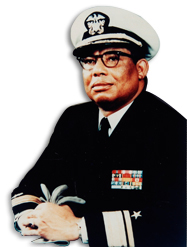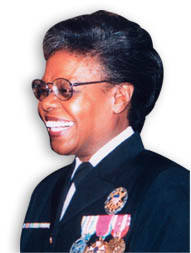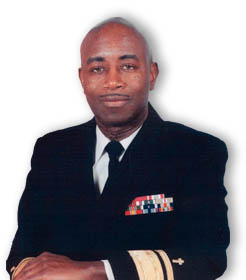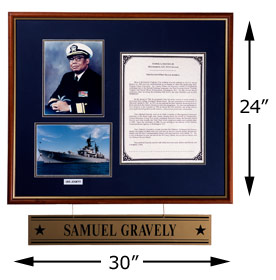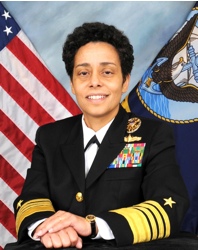


|
The Navy's Black Admirals NASA's Black Astronauts Blacks in Aviation Speaker & Exhibit Series |
|||||||||||||||
|
In 1971, Samuel L. Gravely, Jr. became the first African American promoted to the rank of Rear Admiral. Since that time, 48 other African Americans have reached this rank including Lillian Fishburne selected in 1998. Presently, there are 15 active duty Admirals and 34 retired.
These 49 Admirals exemplify the progress Blacks have made in the Navy, which until late 1940’s maintained strict segregation policies. In 1940, there were 4,000 African-American enlisted sailors in the Navy. They were limited to serving as cooks. The first Black officers were commissioned in 1944 and were nicknamed “The Golden 13”. In 1949, Wesley A. Brown, a Maryland native, became the first Black to graduate from the U.S. Naval Academy at Annapolis, Maryland. Several of the Admirals featured in this exhibit followed in his footsteps, and received their commissions from the Academy including:
Today, there are 78,000 enlisted African-American men and women and an additional 3,000 African-American officers serving in the Navy. "The success of these admirals, along with achievements of all Black Navy Personnel, attests to an impressive record of perseverance. This is their story, a living lesson of personal triumph, and a source of national pride."
This introduction to the United States Navy’s Black admirals is accomplished using color portraits and bibliographical profiles highlighting their brilliant naval careers. The forty-nine 24X30 inch handsomely framed pictures also show a color photograph of the aircraft the admiral flew or the ship they commanded. The exhibit highlights the role Black Americans played in defending our nation and serves as a source of inspiration to all young people that the American dream, of hard work yielding great rewards, can still come true. The exhibit is supported by: • Dynamic documentary videos
• Vice Admiral Sam Gravely; The Navy’s First Black Admiral. • Rear Admiral Barry Black; Called to Serve; The Navy’s First Black Chief of Chaplains. • Rear Admiral Lillian Fishburne; Victory is Mine; The Navy’s First Black Woman Admiral. • Rear Admiral Ben Hacker; The Golden Wings of Naval Aviation. • Seaworthy Admirals: Distinguished Black Graduates of the U. S. Naval Academy. • Admiral Michelle Howard; Leading Lady; The Navy's First 4-Star Admiral.
Special Topics • Wesley Brown; The First Black Graduate of the U S Naval Academy. Book Club Topics for Wesley Brown include: Blue & Gold and Black: Racial Integration of the U.S. Naval Academy
Commander Jackson shares his first-hand knowledge of some of the nation's most dynamic leaders when he facilitates discussions on books written by Black Navy Admirals. From the Hood to The Hill: A Story of Overcoming by Barry C. Black, Retired Navy Admiral and Chaplain of the U.S. Senate Trailblazer: The U.S. Navy's First Black Admiral by Sam Gravely Jr., Retired Navy Admiral, with historian Paul Stillwell Navigating the Seven Seas: Leadership Lessons of the First African-American Father and Son to Serve at the Top in the U.S. Navy by Melvin G. Williams, Retired Navy Admiral
Commander Jackson provides an insider's perspective during his orientation lectures so visitors can get the most from their museum tours. The "New Brigade" exhibit at the U.S. Naval Adademy Museum in Preble Hall, Annapolis, Maryland. This exhibit profiles the lives of Midshipman Wesley Brown, Admirals Paul Reason and Michelle Howard, and astronaut and Marine Corps General Charles Bolden. This exhibit features military trailblazers and Black Admiral and general officers.
|
|||||||||||||||
|
|||||||||||||||
|
Commander Jim Jackson U.S. Navy (Ret.) 1103 Riverboat Ct., Annapolis, MD 21409 410.279.5853
|
